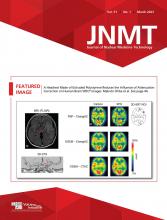Abstract
Besides the known physiologic uptake of 131I, the literature describes various false-positive findings on 131I scans in benign lesions, inflammation, traumatic sites, and postsurgical sites, to name a few. However, to the best of our knowledge, no study has shown false-positive uptake of 131I in a postoperative seroma at the postsurgical site. We describe such a case here.
Radioactive iodine (131I) uptake at the inflammatory or postoperative site is an uncommon finding, with few reports showing false-positive 131I uptake at the site of surgical sutures, subcutaneous injections, postoperative inflammation, or trauma (1–4). Here, we report the case of an elderly man with papillary thyroid cancer who showed postoperative false-positive 131I localization in a seroma. The patient gave informed consent for the study as a part of the institutional protocol.
CASE REPORT
A 61-y-old man presented with insidious, neglected right-sided swelling in the thyroid of 20-y duration, rapidly increasing for the previous 2 y. Contrast-enhanced CT of the neck revealed hypodense lesions in the thyroid gland with enlarged supraclavicular and infraclavicular lymph nodes. He was incidentally diagnosed with multiple myeloma on detailed evaluation and was started on steroids and combination chemotherapy. Cytopathology from the thyroid lesion and right supraclavicular lymph node revealed papillary thyroid cancer. He underwent total thyroidectomy with central and bilateral modified radical neck dissection. Histopathology revealed multifocal classic-variant papillary thyroid cancer, with gross extrathyroidal extension into the strap muscles, angioinvasion, and perineural invasion but free surgical margins. Thirty of 82 resected lymph nodes were involved (largest, ∼1.5 cm) along with the extranodal extension, resulting in a stage of pT3bN1Mx. After surgery, he developed gradually progressive, well-defined, nonpulsatile, and fluctuant bilateral supraclavicular swelling and had undergone multiple therapeutic aspirations from the recurrent right-sided supraclavicular swelling. His stimulated serum thyroglobulin, antithyroglobulin, and thyroid-stimulating hormone levels after thyroid hormone withdrawal were 47.6 ng/mL (reference range, 0–9), 1.9 IU/mL (<10), and 217.5 μIU/mL (reference range, 0.27–4.2), respectively. Whole-body diagnostic and posttherapy (5 d after adjuvant therapy with ∼100 mCi/3,700 MBq) 131I planar and SPECT/CT scans of the neck (Fig. 1) revealed a faintly tracer-avid right supraclavicular hypodense cystic neck swelling (∼9.0 × 4.3 × 6.7 cm) and a non–tracer-avid left supraclavicular hypodense cystic neck swelling (∼2.8 × 2.3 × 2.5 cm). The posttherapy SPECT/CT showed a tracer-avid thyroid bed remnant and a right level IB lymph node, with tracer contamination bilaterally over the thigh regions. Lymphoscintigraphy ruled out lymphocele as the etiology of the bilateral cystic neck swelling. The right-sided swelling yielded clear yellow serous fluid on aspiration, having protein, triglyceride, and thyroglobulin levels of 3.77 g/dL, 10.9 mg/dL, and 4.75 ng/mL, respectively (Fig. 2). Fluid cytology showed sparse inflammatory cells without any malignant thyroid cells. The aspirated fluid counted in a well counter showed a γ-ray emission spectrum with a peak corresponding to 131I γ-energy (364 keV), confirming the presence of radioiodine in the aspirated fluid (Fig. 2).
(A and B) Whole-body diagnostic (A) and posttherapy planar (B) anterior scans showing faint uptake in right supraclavicular region (solid black arrows) and increased uptake at midline of neck (dashed black arrow), in right submandibular region (red arrow), and bilaterally in thigh regions (dotted black arrows). (C–F) CT and SPECT/CT of the head and neck region are shown. Posttherapy CT (C [CT of the neck region] and D [CT of the head region]) and SPECT/CT (E [SPECT/CT of the neck region] and F [SPECT/CT of the head region]) images showing faint tracer avidity in right supraclavicular hypodense collection (solid white arrows), non–tracer-avid left supraclavicular hypodense collection (dotted white arrows), tracer-avid thyroid bed remnant (dashed white arrows), and tracer-avid right level IB cervical lymph node (red arrows).
(A) Test tube containing clear yellow fluid aspirated from right-sided swelling. (B) γ-ray emission spectrum of aspirated fluid, with peak (arrow) corresponding to γ-energy of 131I (364 keV).
DISCUSSION
Only a few reports have shown false-positive 131I uptake in the postoperative and inflammatory sites (1–4), but to the best to our knowledge, no previous study has shown false-positive uptake in a postoperative seroma after thyroidectomy and neck node dissection. The localized inflammatory hyperemia and exudation of radioiodine-containing serous fluid into the postsurgical site may explain the radioiodine localization in this index case. Serous cystic lesions can retain radioiodine by passive diffusion from the blood pool or, as a possible alternate mechanism, a slow exchange of water and chemical elements (5). Though postthyroidectomy seroma formation may be multifactorial, recurrent seroma in this index case despite multiple aspirations might be due to steroid treatment for multiple myeloma (6,7). Moreover, multiple aspirations from the right-sided cystic swelling resulted in frequent microhemorrhages and radioiodine leakage into that cavity but not in the contralateral cystic swelling.
CONCLUSION
Radioiodine localization at the postoperative site on planar scintigraphy may be misleading, but the combination of clinical history, cross-sectional imaging (SPECT/CT), and biochemical and cytopathologic examination proved crucial in guiding the correct diagnosis and management in this index case.
DISCLOSURE
No potential conflict of interest relevant to this article was reported.
Footnotes
Published online Nov. 9, 2022.
- Received for publication June 24, 2022.
- Revision received October 5, 2022.









